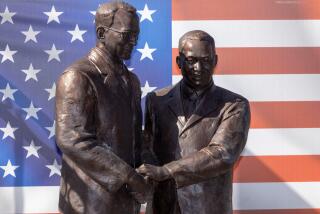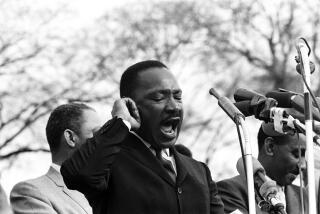For longtime Montgomery resident, chief’s gesture ‘spoke volumes’
Mary Ellen Noone recalls those bleak years in the back of the bus, when her pride would desert her as her parents warned about blacks “knowing their place.”
On rainy days, as she and her mother, Geraldine Bailey, waited for a public bus, the sodden paper grocery bags would often fall apart, making them struggle to corral the contents.
When the bus came, the driver sent them scurrying to the back, so they wouldn’t “get any water on my white customers.” Sometimes, canned goods would drop and roll to the front, the whites-only bastion.
“Mama, what about our groceries?” Noone asked.
“Just let them go,” her mother replied. “Don’t worry about it.”
In time, however, Noone and her family — like blacks throughout the South — began to question their unequal status.
Her aunt was a secretary for the Montgomery Improvement Assn., a group led by the Rev. Martin Luther King Jr. that sponsored the first bus boycotts in 1955 after seamstress Rosa Park was arrested for refusing to give up her bus seat to a white passenger.
Noone was witness to one of the ugliest episodes in Montgomery’s history of racial strife — the day a white mob surrounded First Baptist Church and held 1,500 blacks inside captive. She was among the terrified congregants in the church, and the emotional bruises from the experience lasted decades.
Until last year.
That’s when the Montgomery police chief, a white man, apologized for the department’s role during that violent weekend in 1961.
:::
Growing up in Montgomery in the 1950s and 1960s, Noone recalled, she didn’t feel fear or resentment when she encountered whites.
She felt something else.
“Power,” she said. “They had it. We didn’t.”
One spring day in 1961, Noone and her best friend, Faye Jenkins, heard how a white mob had attacked John Lewis and other Freedom Riders shortly after they arrived in town on a Greyhound bus. Lewis, who decades later would become a congressman from Georgia, was hit over the head with a wooden soda crate and fell bleeding to the pavement.
“It was one of the few times in all of those civil rights marches,” Lewis said decades later, “that I was ever really in fear of my life.”
The mob beat reporters riding with the group. A black youth was set on fire.
Col. Floyd Mann, the state police public safety director, then arrived, firing a round into the air from a snub-nosed, .38-caliber handgun. The crowd froze. “There’ll be no killing here today,” he said.
The mob was finally repelled by state troopers using tear gas. Activists were left bleeding in the street until a hearse from a black-owned funeral home ferried them to a hospital. Montgomery police did nothing to stop the violence.
Noone also knew that a meeting led by King was scheduled the next day at First Baptist Church, whose pastor was the Rev. Ralph Abernathy.
She wanted to go. But her parents said no.
She told them she and Faye were going to the library and would be home by dark. By 3 p.m., the pair sat inside the church with hundreds of others, angry over the previous day’s events. Before them, Lewis stood in the choir section with the other activists, a bandage over his eye.
Outside the church, a white mob began to set vehicles on fire. Then someone cut the electricity to the building.
“We have some sick brothers and sisters outside,” King warned. He called President Kennedy for help, but not before trying to calm the church.
“I still remember his words,” Noone said of King. “‘Peace. Be still.’”
During those tense hours, some fanned themselves throughout the warm Alabama night, some settled down on the floor and tried to sleep.
“It was the first time in my life that I was ever afraid,” Noone said. “Lying on that floor, I could hear my heart beating in my ear.”
To pass the time, the group sang. Without those hymns, Lewis said, the movement would have been “like a bird without wings.”
Recently, Noone stood in her living room in a black Montgomery neighborhood and sang part of “Ain’t Gonna Let Nobody Turn Me Around,” one song the crowd harmonized that day.
Ain’t gonna let nobody turn me around
I’m gonna keep on a-walkin’, keep on a-talkin’
Marchin’ down to freedom’s land!
The next morning, Atty. Gen. Robert F. Kennedy federalized the state National Guard, which led the congregation to safety. Again, Montgomery police had done nothing to quell the unrest.
Meanwhile, Noone’s parents had heard about the mob. They drove downtown but couldn’t get near the church; the streets were barricaded.
“All my mother could see was smoke and flames coming from the direction of the church. She just knew her child was dead,” Noone said. “But we weren’t. We were inside, staying up all night long, singing songs along with everybody else.”
:::
One weekend in March 2013, Noone read a story in her local newspaper. And she rejoiced.
On his annual tour of Southern civil rights battleground sites, former marcher John Lewis, who was now 73, got the surprise of a lifetime, the newscast reported.
Police Chief Kevin Murphy took the microphone before 200 people in First Baptist Church to do something no law enforcement officer had done before: He apologized for his department’s conspicuous inaction when the Freedom Riders came to Montgomery.
“I want to apologize,” he said. “We failed to protect you and the other Freedom Riders. In 1961, the Montgomery police were not very good to you. But today, we’re a better department.”
Reading the news story of the event, Noone got goose bumps.
“I said, wait a minute, let me sit down and write that police chief a note. Not an email, but a real letter.”
Now 72, the retired school administrator wrote Murphy: “Apologizing to Congressman John Lewis on behalf of the Montgomery Police Department, who would not protect us ... spoke volumes! Nobody has ever done that.”
Noone only wishes her ancestors could have heard it too — her parents, grandparents and great-great grandmother, Pinky Powell. As a child, Noone always wondered why the petite family matriarch’s fingertips were so gnarled. Then she learned about that awful day in 1910 when Powell was a child living on a plantation in Lowndes County, Ala.
The owner had given the girl some dried-up nail polish. Powell added some ingredients to make it pliable. The polish made the 12-year-old feel elegant and grown-up. The following day, at a general store, the white proprietor snapped, “What are you doing with your nails painted up like a white woman?”
He then took a pair of pliers and pulled three of the child’s fingernails out of their beds.
“She’d crossed the line and didn’t even know it,” Noone said. “Every time I see red polish I think of that day. And I see red.”
:::
Noone’s father, Dee Johnson Bailey, worked for decades as a butler for Tine Davis, a prominent white businessman. The job instilled in Bailey a healthy disdain for whites in Montgomery.
Years later, when he talked about race relations, he’d grimace theatrically.
“Nothing’s changed,” he’d say.
In 1968, flying home from a job in Washington, Noone met a white salesman en route to Montgomery. He offered her a ride home.
That’s when she decided to play a joke.
“Daddy,” she said at her parents’ door. “I’d like you to meet my fiance.”
Bailey turned gray. “I had never seen that color before in my life,” Noone said, laughing.
“Dad,” she said finally, “I’m just joking.”
“I’ve got to have a drink,” he said.
Her father said the idea of his black daughter marrying a white man gave him nightmares. “All I could see was this big old white cross burning on my grass,” he’d joke.
Years later, in 1988, Noone returned to Montgomery from years living in California and felt the sting of old tensions. “I said, ‘Oh my God, what’s this?’” she recalled. “And then, ‘You know what it is. You’re not stupid.’ I’d hear my Daddy’s voice in the back of my head.
“‘Nothing’s changed.’”
:::
Whites rarely, if ever, come to Noone’s part of town. Those who do are either police officers or salesmen. She still has no close white friends here to speak of.
Though rarely acknowledged, she says, race is always right there, just under the surface. Sometimes it’s even blatant. Noone recalls a story told by a friend at the beauty parlor about her job as an aide in a nursing home with a mainly white clientele.
As the worker bathed an old white woman — nearly 100 years old and largely senile — the patient looked up at her and slowly drawled the old profane epithet. The N-word.
Noone summed up the lasting effects Murphy’s apology has had on Montgomery race relations.
“What it told black people was, ‘I understand.’ He acknowledged our pain, which is more than most white people have done.”
More to Read
Start your day right
Sign up for Essential California for news, features and recommendations from the L.A. Times and beyond in your inbox six days a week.
You may occasionally receive promotional content from the Los Angeles Times.






